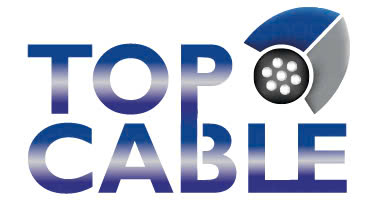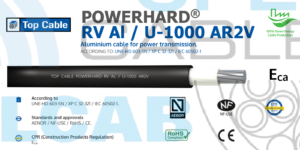ALUMINIUM CABLES
Aluminium cables for power transmission.
TOXFREE ZH RZ1 (AS) AL
Aluminium halogen free (LSHF) cable for power transmission
TOXFREE ZH RZ1 (AS) AL is an aluminium LSHF cable for fixed installations. In the event of fire, it does not emit toxic gases, nor does it give off corrosive gases, avoiding any possible damage to people or electronic equipment. These cables are especially recommended for installation in public places and in installations where safety is a priority.
POWERHARD RV AL / U-1000 AR2V
Aluminium cable for power transmission.
This Aluminuim cable POWERHARD RV AL U-1000 AR2V is suitable for all types of underground networks for public power distribution, as well as low voltage connexions in industrial plants, urban networks, buildings, etc. Due to its rigidity, its use is recommended in installations with a simple configuration where a flexible cable is not needed.
TOPSOLAR PV AL 1500V
Aluminium PV cable.
DC Feeder Aluminium 1500 PV cable is suitable for all types of underground and open air solar installations. This cable is recommended for connections between string boxes and photovoltaic inverters in large scale rooftops or ground farms.
TOPSOLAR PV LSZH Al 1500 V HEAVY DUTY
Aluminium cable for buried photovoltaic installations
The TOPSOLAR® PV LSZH AL 1500V HEAVY DUTY cable can be directly buried in most soils. They can be installed in smaller trenches as no sand or external backfill is required. The special outer sheath compounds make this cable highly resistant to possible shocks and friction during its installation (impact and tearing). In addition, the cable is AD8 water resistant (submersible). Finally, this cable resists degradation caused by ultraviolet (UV) rays as it is tested for UV protection according to the solar standard EN 50618.
TOPSOLAR PV AWA/SWA AL 1500V
Aluminium or galvanized wire armour cable
The TOPSOLAR® PV AWA/SWA DC Feeder Aluminium cable is suitable for all types of underground and open air solar installations. This cable is recommended for connections between string boxes and photovoltaic inverters in large scale rooftops or ground farms. Suitable for transport and distribution of electric power where there is the possibility of mechanical aggressions.
Top Cable, a global supplier to the world’s aluminium power cables.
At Top Cable we have a wide range of aluminium cables designed and produced by our team of experts. Aluminium cables are lightweight and have the ability to withstand extreme weather conditions, such as high temperatures and hostile environments (susceptible to attack from rodents or other natural threats), making them highly recommended for outdoor installation projects. Aluminium cables are also highly resistant to corrosion, so they can last for a long time without being replaced.
FREQUENTLY ASKED QUESTIONS (FAQ) ON ALUMINIUM CABLES
What are the 5 best practices for Aluminium cable installation and maintenance?
Aluminium cables require careful handling and installation to ensure their longevity and safety. Here are some tips to follow when installing Medium Voltage aluminium cables:
- Cable selection: to ensure proper MV cable selection it is highly recommended to consider factors such as voltage rating, insulation type, fire safety norms, and environmental conditions, as well as the adequate aluminium cable cross-section.
- Cable handling: aluminium cables can be easily damaged if not handled properly. Avoid bending, twisting, or pulling the cables, and be careful not to drop them. Always use proper lifting equipment when moving heavy aluminium cables.
- Cable installation: a cable installation should always be carried out by trained and experienced personnel. Compliance with international and local electrical codes and regulations is essential to ensure the reliability, safety, and longevity of the installation.
- Waterblocking: aluminium cables are susceptible to corrosion when exposed to moisture. Make sure to keep the cables dry during installation and operation, and protect them with cable ends to avoid premature failure of the cable, accessories, or electrical equipment.
- Cable maintenance: periodic cable inspections should be performed visually and with the use of specialized test equipment to identify any signs of damage, wear, or deterioration, ensuring the longevity and reliability of the electrical installation.
By following these tips, you can ensure that your aluminium cables are installed correctly and will provide years of reliable service.
What is the difference between aluminum or copper cables?
Aluminum cables are lighter and less expensive than copper cables. Aluminum is also more resistant to corrosion than copper. Copper cables are more conductive and less susceptible to interference than aluminum.
The conductors can also be tinned copper, such as those required for solar installations. (More info here).
Generally speaking, we can determine that the type of installation and the certification standards required by the project will determine the suitability of one conductor or another.
Are aluminium cables better than copper cables?
Copper and aluminium, the two most widely used metals in electrical wiring, offer distinct advantages and disadvantages. Aluminium cables offer a viable and sustainable alternative to copper cables in numerous electrical applications, providing significant advantages in terms of cost, weight, and corrosion resistance. However, aluminium’s conductivity is approximately 60% that of copper. Check the specific demands of your industry or ask for advice from Top Cable.
Are Aluminium cables cheaper than copper cables?
Yes, aluminium cables are cheaper than copper cables. Aluminium cables offer a viable and sustainable alternative to copper cables in numerous electrical applications, providing significant advantages in terms of cost, weight, and corrosion resistance. Compliance with international and local electrical codes and regulations is also essential to ensure the reliability, safety, and longevity of the installation. Discover how our Aluminium cables can benefit your installation needs and ask for an RFQ on Aluminium cables from Top Cable to get started. We would love to hear from you.
What are the benefits of using aluminium cables?
Aluminium has proven itself to be corrosion-resistant in practical situations.
Are Aluminium cables recommended for wiring PV systems?
Yes, Top Cable manufactures a wide range of Aluminium cables specially designed for renewable energies such as solar farms or rooftop PV installations. For example, The TOPSOLAR® PV AWA/SWA DC Feeder Aluminium cable is suitable for all types of underground and open air solar installations. And the TOPSOLAR® PV LSZH AL 1500V HEAVY DUTY cable can be directly buried in most soils. Ask for an RFQ on Aluminium cables from Top Cable.
Can Aluminium cables be LSZH for use in public places?
Yes, Top Cable manufactures Aluminium LSZH cables that can be installed in public places and hazardous locations where there is a risk of fire. For example, the TOXFREE RZ1 is an Aluminium Low Smoke Fire Resistant cable, with tbe best CPR fire performance: B2ca -s1a, d1,a1.
What are the main aluminium cable standards?
One of the most important Aluminium cable standards is the EN 60332-1, published by the International Electrotechnical Commission (IEC). This standard specifies the general requirements for the design and construction of aluminium cables for use in power distribution systems. Another important aluminium cable standard is the NFC 32-070 standard, which is published by the French Association for Standardization (AFNOR). This standard specifies the requirements for the installation of aluminium cables in electrical installations.
Why is aluminium used in overhead power cables?
An aluminium cable has a 1,5 times larger cross section to pass the same current as a copper wire, but two times lighter. So, the light weight of aluminium is the main reason for using aluminium instead of copper in overhead connections.
Why is aluminium not used in power cables?
Copper has high electrical conductivity and low resistance than aluminum, that’s why it is used for electrical wiring. Also, aluminum wiring is susceptible to expansion and contraction, which can lead to electrical arcing. Aluminum wiring heats and expands as electricity flows through it, and cools and contracts when the flow of electricity is cut.
Why do high voltage power cables have aluminum cores?
Aluminum is the best material for high-voltage transmission lines, as overhead power cable has to be light and flexible in addition to being durable. Aluminum is a malleable material that is less prompt to compression stress compared to copper.
How do aluminium cables compare to copper cables in terms of performance?
Although an aluminium conductor has a conductivity of approximately 61% compared to a copper conductor of the same size, its weight is three times less, which makes it much easier to handle. For this reason, aluminium is preferred in large cables and overhead power distribution.
What applications are low voltage aluminium cables best suited for?
Low voltage aluminium cables are best suited for a variety of applications, including:
- Power Distribution: They are commonly used in electrical distribution networks to transmit power from substations to residential and commercial buildings.
- Industrial Applications: Aluminium cables are often used in factories and industrial plants for powering machinery and equipment due to their lightweight and cost-effective nature.
- Renewable Energy Systems: These cables are suitable for connecting solar panels and wind turbines to inverters and power distribution systems.
- Underground Installations: Aluminium cables are frequently used in underground installations because they are resistant to corrosion and can be installed in various environments.
- Street Lighting: They are ideal for street lighting systems, providing a reliable and efficient means of power supply.
- Temporary Power Supply: Due to their lightweight properties, aluminium cables are often used for temporary power setups at events or construction sites.
- Residential Wiring: In some cases, they can be used for residential wiring, especially in larger homes or developments where cost and weight are considerations.
Overall, low voltage aluminium cables are favored for their balance of performance, weight, and cost in various electrical applications.
How to properly install low voltage aluminium cables?
Installing low voltage aluminium cables requires careful planning and adherence to safety standards. Check IEC – International Electrotechnical Commission- standards for more details.
What are the thermal expansion properties of aluminium in low voltage cables?
The thermal linear coefficient of expansion for aluminum is 36 percent greater than copper.
How do aluminium cables compare to copper cables in terms of conductivity?
Copper has a higher electrical conductivity than aluminium. Specifically, copper’s conductivity is about 60% higher than that of aluminium. This means that for the same cross-sectional area, copper can carry more current than aluminium.
Cáp Điện Lõi Nhôm TOP CABLE 0.6/1KV POWERHARD RV AL / U-1000 AR2V BLACK | Chính Hãng – Giá Tốt Nhất
Cáp Điện Lõi Nhôm TOP CABLE 0.6/1KV POWERHARD RV AL / U-1000 AR2V BLACK |...

